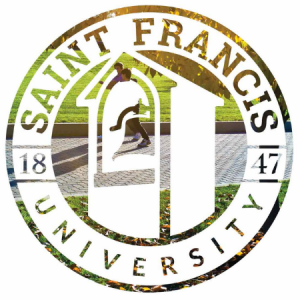7th Annual Student Research Day
11/16/2017
Saint Francis University hosted the 7th Annual Student Research Day on November 16th in the John F. Kennedy Student Center. Fifty-four posters and four talks were presented by students from all majors. The event gave students an opportunity to showcase and discuss their research with the university community .
Tiny Classroom Big Impact Project is Officially Underway 2017
07/26/2017
The project to build a Saint Francis University Tiny Classroom is officially a reality! The Tiny Classroom Big Impact project, currently under construction, will provide hands-on, renewable energy education for SFU students and community members in central and southwestern Pennsylvania. A year ago, the Institute for Energy dreamed an idea to construct a tiny mobile classroom. They envisioned the classroom would utilize renewable energy and serve as a teaching tool about sustainability and power technologies for communities in the region. Two local organizations are making that dream come true
PNGE Undergraduate Research 2017
07/20/2017
The Petroleum and Natural Gas Engineering program at SFU strongly encourage and support undergraduate students to involve in academic and industrial research projects. In these research projects, students have the opportunities to develop new skills, present their research results in national/international professional conferences, publish conference proceedings or peer-review journal articles, and meet external professors and industrial engineers. Our university, department and PNGE program have invested a lot in undergraduate student research by providing facilities, funding, etc. The Coming
New Research on Bolivian Mines
05/24/2017
Loretto, Pennsylvania — Researchers from Saint Francis University, the University of Oklahoma, and Pennsylvania State University have found that exposure to trace metals from potatoes grown in soil irrigated with waters from the Potosi mining region in Bolivia may put residents at risk of non-cancer health illnesses. The world’s largest silver deposit lies in this region, and exposure to mining pollution from contaminated irrigation waters worries residents. “In this high mountain desert, water is a critically precious resource and the use of metal-polluted waters for irrigation may have
Tiger Spiketail dragonfly discovery
04/25/2017
One of the things that makes Saint Francis University different from other colleges is our commitment to research and faculty mentorship. Our students conduct research in small teams that work closely with faculty members in dedicated student/faculty research labs. Many students begin research as freshmen, and students can work with multiple faculty on different projects over their four years. Two first-year SFU Biology students, Taylin Lehman and Morgan Ruis, along with Associate Professor Dr. Lane Loya, recently discovered larvae of the rare Tiger Spiketail dragonfly ( Cordulegaster erronea
The water monsters
04/24/2017
Meet Mudkip and Wooper, the two newest members of the The Dr. Wayne and Elizabeth Takacs Biology Department . The axolotls, also known as Mexican salamander, are actually amphibians and not walking fish, although they do spend their entire lives in water. The axolotl’s name is derived from the Latin words “atl” (water) and “xolotl” (monster). They retain their larval features as adults and never go through metamorphosis. The axolotls are currently the eighth most endangered species in the world with less than 100 individuals currently left in the wild. Their natural habitat is in an area of
Stephanie Wilson Profile
02/21/2017
Ms. Stephanie Wilson is a senior Biology major with a Marine Biology and Environmental Science concentrations. In addition to her coursework, she has traveled, engaged in a variety of campus activities, and has contributed much time and energy to the Dr. Wayne and Elizabeth Takacs Biology Department and the School of Sciences in general. Last year, she was been actively involved in the maintenance of the 1500-gallon aquarium at SFU and the care of many specimens in the marine lab in addition to being a Work Study Assistant to the Dean of the School of Sciences, a Microbiology Lab Prep
Allison Rohrs receives Energy Leadership Award
11/02/2016
Allison Rohrs, director for the Institute for Energy at Saint Francis University, recently received the Women in Energy Leadership Award by the Pittsburgh Business Times . Rohrs was one of 26 women in the region to receive the 2016 award. The honorees were selected by a panel of industry experts and honored at an event and in a special edition of the Pittsburgh Business Times in October. Rohrs has served as the director for the Institute for Energy at Saint Francis for nearly four years. In her role, she works with local small businesses and farmers to help assess their properties for
Saint Francis welcomes Fulbright Scholar Dr. Ruben Mamani
09/06/2016
The Saint Francis University School of Science, Environmental Engineering Program , and Center for Watershed Research & Service is pleased to welcome Fulbright Scholar Dr. Ruben Mamani to campus. Dr. Mamani hails from Bolivia and has expertise in air quality and international development projects. He has contributed to research projects investigating air pollution and climate change in the high Andes of Bolivia. He studied the transport of aerosols from Amazonian biomass burning reaching the glaciers of the Andes mountains as an associate researcher at the Atmospheric Physics Laboratory of
SFU Biology Students Search for Diversity in Polluted Waters
08/03/2016
Have you ever come across a stream or pond that was full of a thick, murky, orange sludge? You likely saw a case of Abandoned Mine Drainage (AMD) pollution. AMD occurs when acidic, metal-rich water emerges at the surface after passing through abandoned coal or clay mines. These metals then precipitate in a thick, orange sludge called “yellow boy” that can smother life in streams and ponds. This summer, two teams of SFU Biology students studied the effects of pollution on freshwater biodiversity. Dr. Lane Loya and Dr. Justin Merry teamed with a group of four biology students as well as faculty
